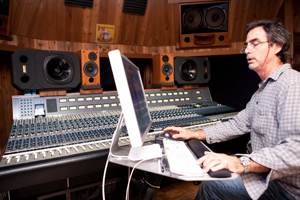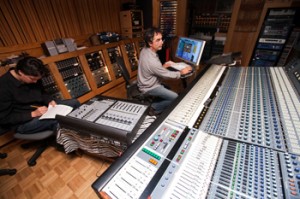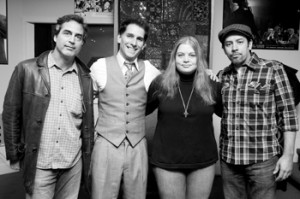Key to Keys: Tony Maserati, Mixer
Tony Maserati swooped down to Long Island from his upstate, NY studio to lend a hand in mixing some of the 20 songs produced as part of Alicia Keys’ The Element of Freedom. As deadlines approached, Keys’ chief engineer and album coordinator Ann Mincieli made the game-time decision to get Maserati set up and cranking on mixes at Pie Studios, located near The Oven.
Maserati has mixed records for some of the biggest voices in pop music, including Beyonce, Black Eyed Peas and Jason Mraz, and R&B crooners like John Legend, Mary J. Blige and Lizz Wright. Having worked with everyone on the team before, he and assistant Stuart White were a welcome addition and fell right into the groove at The Oven.
Here, we chat with Maserati about his experience mixing Alicia Keys and why being a part of this particular team-effort felt oh so good….
So while everyone else is jamming at The Oven, you’re mixing at Pie Studios? Tell us about that place.
The board is a Neve 8068, and it’s like it came out of the factory yesterday. I’ve never seen one in such great condition. It’s perfect. He’s got five LA-2A’s, five LA-3A’s. He’s got a GML, an old Fairchild.
I use the Neve 8068 as a summing bus. I don’t ride faders on a console, I just set all the faders at zero, that’s it. Then, I’ll use the EQ’s on a vocal, but for the most part, my assistant can recall everything in ten minutes. But, I use a lot of outboard gear. I’ll switch things up as I’m working.
I’ll use two chains on the lead vocal, using one for one song, one for the other song, so I don’t have to disturb the one that’s in progress while I’m waiting for Alicia’s comments. We can double click and bring up a new mix with only a couple of little adjustments. So as I work on songs, I’ll go back and forth through the chains that I use.
Have you ever worked in a situation like this? With everyone in-house, working as a team?
Yes, I’ve done this several times, and I’ll tell you the big difference here. First of all, Ann Mincieli — she’s a complete genius, coordinating and manifesting the most creative situations for her artist that she knows so well. She heard what her artist wanted and she implemented it.
But the really cool thing about this particular team effort is that most of the time, those kinds of arrangements end up being everyone servicing the leader, whoever that is. Sometimes it’s the producer, sometimes it’s the artist, and that may be the same person in some cases.
But in this case, it’s the music — everyone is working in service to the music. We’re all here to service the songs. Even the assistants and the runners; they’re excited to hear what you did on song x. The whole thing here is servicing those songs and I’ve never experienced that before at such a high level. And, I don’t feel like I’m chasing something. I’m allowed to be creative, I’m hired to do my thing, and it’s like the artist is here working with my creativity, and geez, that’s the best feeling you can have.
So, the fact that everyone’s so on-board, so into the music, do you think that speaks to just how good the music and songwriting actually is?
I think it speaks to a lot of things. First of all to Alicia’s talent and the fact that she’s just so good at what she’s doing. She’s so smart and extremely creative, always in tune with your feelings, just an amazing character. She comes into the room, and everyone is excited. It’s a great thing. That’s why we all got into this business.
She brings that, and Ann has created an environment for her to be that way, so she doesn’t have to think about tiny little details about technology. Alicia knows what she’s doing technically, but she just doesn’t have to think about it.
As a mixer, what’s it like working so closely with another mixer on the same record?
I don’t really even know how Kerry and Alicia are making their decisions about who mixes what. I’m not even thinking about it. I’m here, completely at their service. I consider Manny as her engineer/mixer person. He’s had tremendous hits with her. I loved As I Am.
I think I’m here for an alternative, experimental sound. I think some of the tracks I’m doing are going to be on the record, a lot of them will be B-sides. She uses a lot of different people, musicians and co-writers. She’s good enough to try a lot of different things, and find her center. Manny is her center as far as mixing, and clearly he’s good at it. You hear his mixes and they sound like Alicia Keys hits. Mine are a little different. I’m just happy to be in the vibe with Alicia.
You’re based in upstate New York. What did it take to set up camp at Pie?
It was really simple. I brought a couple of Digidesign 192 I/O interfaces. I use hardware inserts all the time, that’s really the way I connect to the analog world, other than summing analog. I’ll sum 32 channels of analog, and then I’ll have 24 channels of hardware inserts. So essentially I’ve got 32 channels of Neve desk summing going on, with all those 32 channels of Neve 31105s happening over there, and then I’ve got 24 channels of hardware inserts which are LA-2A’s, GML’s, LA-3A’s, Fairchild, Distressors, API’s — tons of great analog gear.
You’ve had your hands on your fair share of gear. Is there anything new at Pie for you to use?
He’s got equipment that’s so old, it’s new to me. He’s got RCA compressors that I’ve never tried before. He’s got an EMT 250 — I haven’t seen one in 15 years. A couple Daking compressors with cool emulation settings of Neve and Fairchild, which I’ve got API 550s in front of.
What’s the mixing chain you’ve set up for Alicia’s vocals?
Because Alicia has so many different musical characters, I had to create different ways to work on her vocals. At first, I worried that everything I was doing sounded too EQ’d, or too compressed. Manny’s advice to me was “try working the compression to manipulate the frequencies in the vocals.”
Basically, you can’t do a lot of EQ, you can’t to a lot of de-essing, you can’t do a lot of anything. She’s so good at mic technique, and Ann is so good at mic selection. She’s got a really great, full voice, and there’s a lot of dynamics still in her records, more so than on a lot of records out there right now.
I’ve been using the Chandler Limited TG1 quite a lot lately, naturally I tried that first, but it didn’t work with her approach or style. I started changing things up a bit — switching the order of compressor and EQ as well as adding some parallel compression with an 1176. That helped bring back some of the dynamics while allowing it to remain loud and present in the mix. On some songs, I tried the RCA BA6, LA-2A and the LA-3A, all with very minimal compression.
Has this project given you new ideas? What can you carry forward and apply next? Perhaps even with the workflow?
As a mixer, every gig is custom. But on the workflow, I really appreciated how I was able to work closely with Ann and with many engineers, and discuss what ideas I had that they might have. And then to be able to play it for Dave Kutch and get on-the-spot comments, that’s awesome and it’s certainly very beneficial to the work. It’s rare though. I can’t imagine it’s going to happen again anytime soon. — SonicScoop









